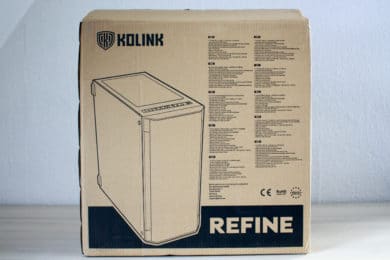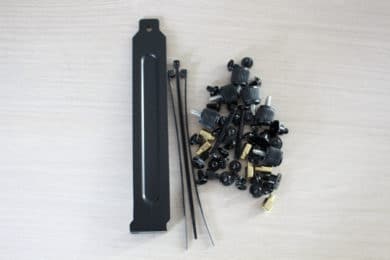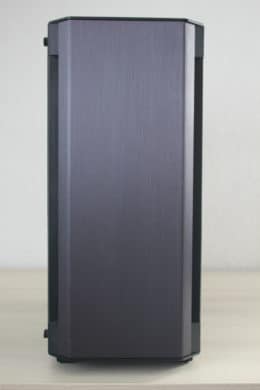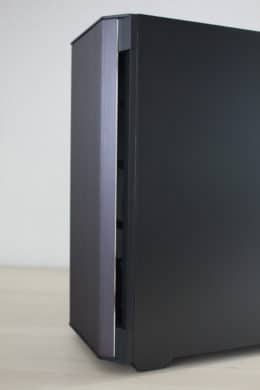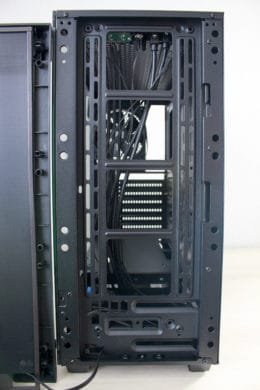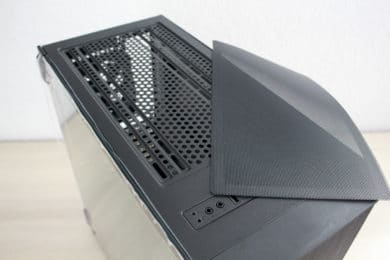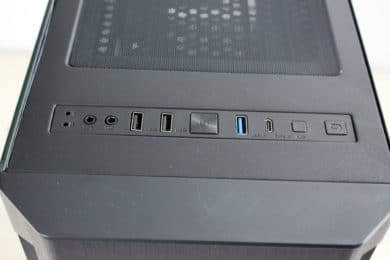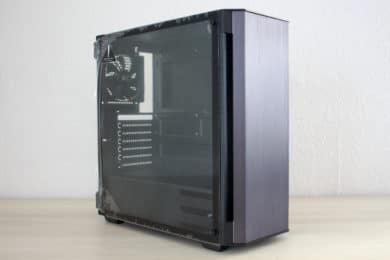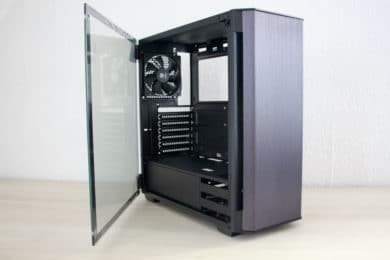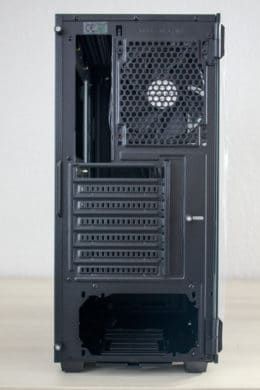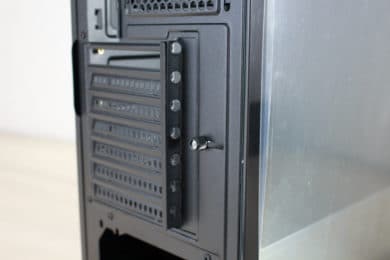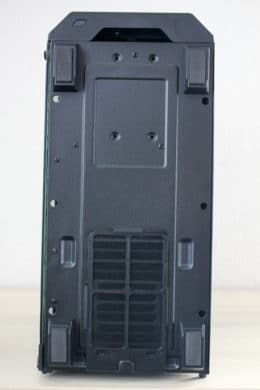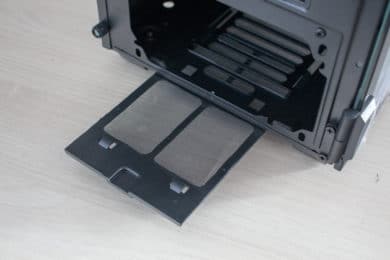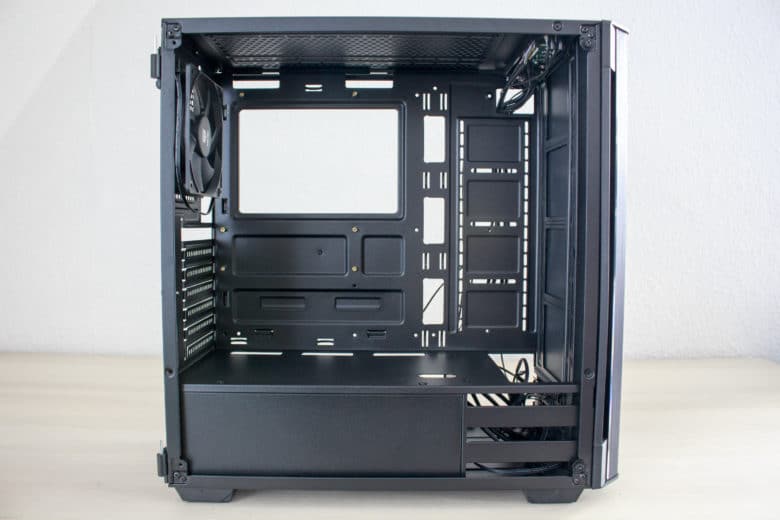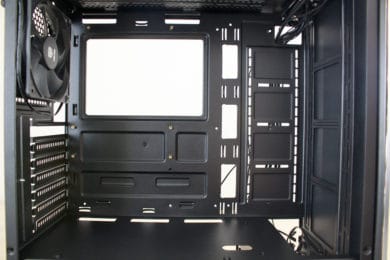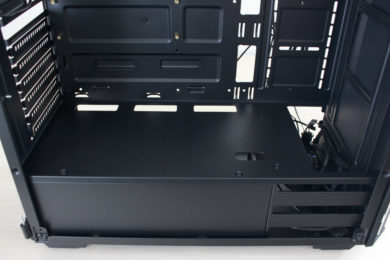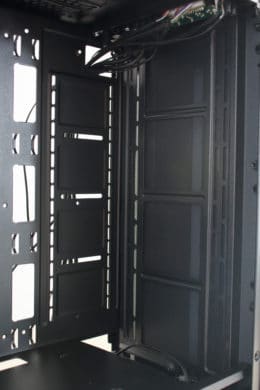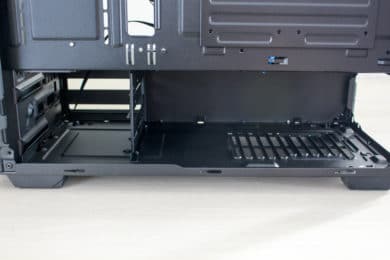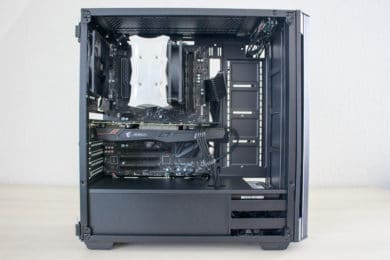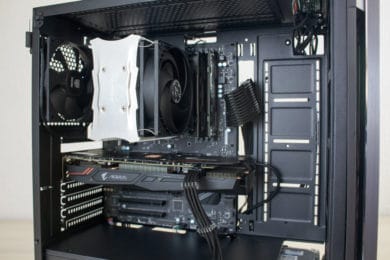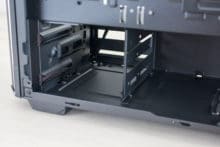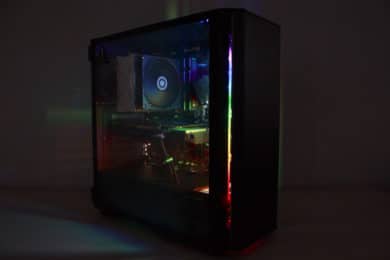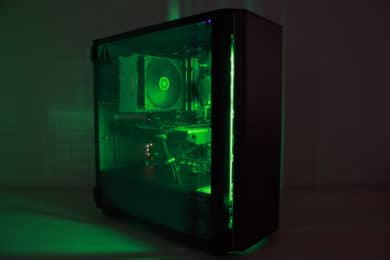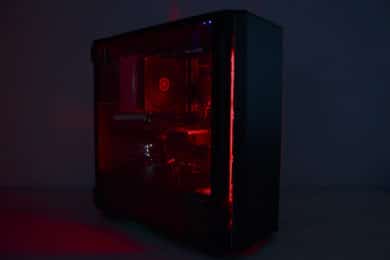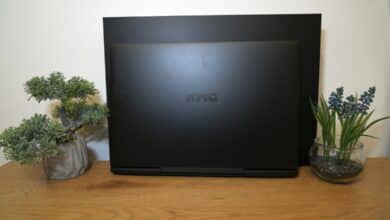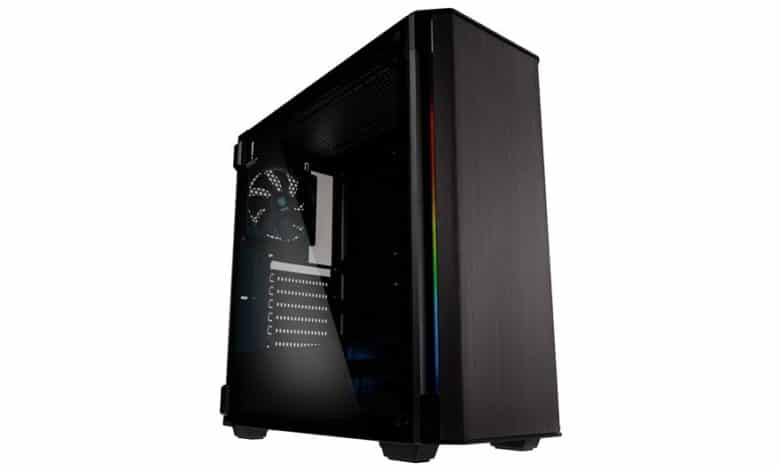
The manufacturer Kolink recently introduced two new midi tower enclosures. One of these new products is called Refine RGB and is a normal sized midi tower with tempered glass. Further features are the aluminium front, the support of two 240 mm radiators and a lot of space and airflow for “powerful” hardware. The Kolink Refine is only available in a black version and currently costs € 72.75 *.
Whether this price is justified for the Kolink Refine RGB and how it performs in general, we will find out in this review for you.
Technical Details
| Model: | Kolink Refine RGB |
| Housing type: | Midi Tower |
| Dimensions: | 205 x 435 x 455 mm (W x H x D) |
| Weight: | approx. 5.9 kg |
| Material: | steel, plastic, tempered glass, aluminium |
| Color: | Black |
| Front connections | 1x USB 3.1 Type-C, 1x USB 3.0 Type-A, 2x USB 2.0 Type-A, 1x Speaker, 1x Microphone |
| Drive bays: | 2x 3,5″/ 2,5″ (HDD cage, internal) 2x 2,5″ (motherboard tray, internal) |
| Extension slots: | 7 |
| Form factors: | ATX, mATX, mini-ITX |
| Ventilation: | Front: 2x 120 mm or 2x 140 mm Rear: 1x 120 mm cover: 2x 120 mm or 2x 140 mm |
| Radiators: | Front: 1x 280 mm or 1x 240 mm Rear: 1x 120 mm |
| Max. CPU cooler height: | 160 mm |
| Max. Graphics card length: | 380 mm |
| Max. Power supply length: | 200 mm |
| Cable management space: | 20 mm |
| Place for front radiator: | unlimited (restricts GPU length) |
| Price: | € 72.75 * |
| Special features: | Dust filter, cable management, glass side panel, RGB, aluminium |
Scope of Delivery
Like all Kolink cases, the Refine comes well and safely packed in a brown cardboard box with black lettering and is wrapped in normal Styrofoam. Furthermore, the manufacturer has covered the glass element with two additional protective films to protect it from scratches. The included accessories were fixed in a transparent plastic bag inside the case with a cable tie. This bag contains all important screws, a few cable ties, and a plastic PCI replacement cover. Also included are the pre-installed case fan, the RGB element in the front, two magnetic dust filters and the partially pre-installed spacers.
Exterior Impression
With the Refine Kolink relies externally rather on understatement. The front element is dominated by a large smooth surface of genuine brushed aluminium. This is not only very chic but is not a matter of course in this price range. At the corners, the aluminium is slightly bent and runs in the direction of the side parts. Kolink has large ventilation slots on the left and right sides of the front element. If the front is removed, a magnetic dust filter and mounting rails for fans in 120 or 140 format are revealed.
If you raise your eyes and look at the lid section, you can also see a large fan opening and a magnetic mesh dust filter. Before the fan opening, the manufacturer has fixed the I/O panel. Here, too, there is a small special feature for the desired price. Besides the typical ports like 2x USB 2.0, 1x USB 3.0, 1x microphone and 1x headset, the Refine even has a USB 3.1 Type-C port. When checking the internal plugs, however, the first disillusionment comes. The USB Type C port also only has an internal USB 3.0 header. If you don’t have a motherboard with two internal USB 3.0 headers, you can’t connect all front I/O ports.
The right side part of the refine is completely made of steel and appears sufficiently stable. By using knurled screws and a pull-out aid the disassembly of the sidepanel should be made easier. The left side part consists of a four millimetre thick glass (Tempered Glass) and has practical hinges with which it can be easily opened. To prevent this from happening unintentionally, there are two flat knurled screws in the front area that hold the panel in place. For the installation of all components the side panel can also be completely removed if required.
The Midi Tower stands on four solid plastic feet. For the protection of sensitive surfaces and for decoupling these feet were additionally provided with a rubber strip. The power supply to be positioned on the ground is protected by a fine and easy to remove fabric filter. Otherwise there are no further characteristics at the underside which are noteworthy.
The same applies to the back. Here you can find everything you might expect from a normal sized midi tower. The power supply is mounted at the bottom. Above there are seven PCI slot apertures. Typical for Kolink housings these bezels are unfortunately not reusable and have to be broken out before installing the mainboard. Finally, the only pre-installed fan with a frame width of 120 millimeters should be mentioned here.
The general processing quality and paintwork are borderline. Sometimes the material is relatively thin and the paintwork is very rough everywhere. For a price of € 72.75 * the processing must definitely be better.
Internal Impression
Kolink remains true to its previous design for the interior. If you’ve already read one or two of the Kolink reviews on this blog, you’ll notice that the interior or body is identical to that of the Kolink Levante or Horizon. This leads to a modern division into two chambers by a power supply cover.
In the upper area, the mainboard, graphics cards and air coolers or water coolers are placed. To ensure optimal airflow, there are no drive bays or other disturbing elements behind the optional front fans. All around the mainboard there are appropriately dimensioned cable management openings in the mainboard tray. The lower area is completely covered by a power supply cover. This was also equipped with cable management openings.
Let us now turn to the back of the interior. Below the power supply cover there is a hard disk cage for two 3.5″ HDDs and of course the mounting place for the power supply. Unfortunately, the hard disk cage has no decoupling mechanisms and cannot be removed. The stand-offs for the power supply are also made of steel and have no rubber strips. SSDs can only be attached directly to the mainboard tray in the refine. Here the mounting takes place over a large steel plate.
Also the processing in the interior shows weaknesses. The paintwork is also very rough and the material is very thin in some places. For example, the mainboard tray or the power supply cover can be moved visibly with a finger. But fortunately there are no sharp edges in the refine.
System Construction in Kolink Refine
Now we come to system installation. As hardware we use a AMD Ryzen 5 1400 on a MSI B350 PC Mate with 16GB Crucial Ballistix Sport LT grey DDR4-2666. The Ryzen is cooled by an EKL Alpenföhn Matterhorn Pure. For the image output a GTX 1060 6GB of Gigabte AORUS is responsible. The power supply does the non-modular Berlin Pro RGB 650W with RGB fan. In order to enhance the cabling optically a little bit, single sleeved cable extensions from Phanteks.
As in Kolink Levante, the installation of all components in the refine was very easy and fast. Due to the well positioned and dimensioned cable management openings and the 20 millimeters behind the mainboard tray all cables could be laid properly. In general, the space conditions in the Kolink Refine are quite ample anyway. For CPU coolers, a maximum of 160 millimeters of space are available. This is sufficient for many powerful coolers. But the buyer doesn’t have to worry at all about the length of the graphics card. With a maximum possible length of 380 millimeters, every pixel accelerator should fit into the refine.
The assembly of the data carriers requires the use of a screwdriver in all cases. Large 3.5″ hard drives are accommodated in the HDD cage at the front of the case. For mounting, the HDD is first equipped with two special rail screws on the left side and then pushed into the slot. Then the data carrier is fixed with a knurled screw on the right side. Two SSDs can be attached to a steel plate behind the mainboard tray with four normal screws each. Unfortunately there is no decoupling.
The pre-installed case fan has a frame width of 120 millimetres and rotates at a maximum of 1300 revolutions per minute. It is connected directly to the mainboard via a black 3-pin connector. At full speed, the fan is audible, but not disturbing.
Finally, we come to the temperatures that were reached in the refine. During the load test, Prime95 and FurMark were run for 15 minutes at a room temperature of 18 °C. The test was performed at a temperature of 18 °C, and the temperature of the CPU was very low. Additionally, this test was carried out in three different variants (case fan to 100%, case fan to 50%, without sidepanel).
Scenario |
Temperature |
| CPU: 50% PWM (1150 rpm) GPU: 50% PWM (1650 rpm) Housing: 100% (1300 rpm) |
CPU: 75 °C GPU: 65 °C |
| CPU: 50% (1150 rpm) GPU: 50% PWM (1650 rpm) Housing: 50% (950 rpm) |
CPU: 82 °C GPU: 67 °C |
| without sidepanel CPU: 50% (1150 rpm) GPU: 50% PWM (1650 rpm) Housing: 100% (1300 rpm) |
CPU: 68 °C GPU: 56 °C |
Overall, the airflow in the Kolink Refine is not quite as good ex works. If the pre-installed case fan is lowered, the overclocked Ryzen reaches a slightly alarming 82 °C. The airflow in the Kolink Refine is not quite so good ex factory. The graphics card is even better with 67 °C. The additional test without sidepanel shows that two additional front fans would fit the Refine very well to reach better temperatures.
Lighting Options in the Kolink Refine RGB
In comparison to the Kolink Horizon or Levante, the manufacturer also dispenses with RGB fans for the Refine RGB and uses an attractive RGB element in the front. This was hidden on the back of the front panel and discreetly illuminates the fan openings in the front and the interior. By using a 3-pin 5V RGB connector, the RGB strip can be addressed digitally via the mainboard. If the mainboard does not have such a connector, there is a switch on the I/O panel and the RGB element can be powered via an old-fashioned Molex plug. The switch in the I/O panel cannot be used to switch the RGBs. Kolink has added another switch to the bottom of the front panel.
Finally we’ll give you some impressions how the lighting looks like in action.
Conclusion of the Kolink Refine RGB Review
The goal of the manufacturer Kolink is to offer inexpensive products with a good processing quality and equipment. Also with the Refine this goal is recognizable however not well converted in parts. A front made of real aluminium, a side window made of tempered glass mounted on hinges and a digitally addressable RGB element make this Midi Tower a real eye-catcher. Kolink also didn’t let himself get tired of the space and equipment of the I/O panel. The USB type C connection, which is virtually never available in this price class, is only a special feature at first glance. This connection is not made via an internal USB 3.1 header but via a normal USB 3.0 header.
Apart from that the € 72.75 * doesn’t offer any other expensive features that wouldn’t be available in current 40-50 € cases. Especially the partly weak material thickness and the very rough varnishing don’t correspond to the demanded price. Overall the Kolink Refine is a good case, but in our eyes the price is a bit too high for the whole package.
Kolink Refine RGB
Workmanship
Structure
Features
Cooling
Value for Money
Well equipped housing with aluminium, RGB and tempered glass, but with weaknesses in workmanship.


